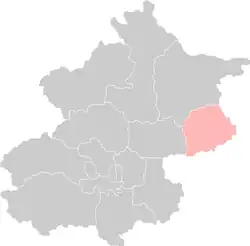Pinggu, Beijing
Pinggu District (simplified Chinese: 平谷区; traditional Chinese: 平谷區; pinyin: Pínggǔ Qū), formerly Pinggu County (平谷县), lies in the far east of Beijing Municipality. It has an area of 950 square kilometres (370 sq mi) and a population of 396,701 (2000 Census). The district is subdivided into 2 subdistricts, 14 towns, and 2 townships. It borders the Beijing districts of Miyun and Shunyi to the north and west, respectively, Tianjin's Jizhou District to the southeast, and in Hebei province, Xinglong County and Sanhe to the northeast and south, respectively.
Pinggu
平谷区 Pingku | |
|---|---|
.jpg.webp) Yaji Mountain | |
 Pinggu District in Beijing | |
| Coordinates: 40°8′32″N 117°6′4″E | |
| Country | People's Republic of China |
| Municipality | Beijing |
| Township-level divisions | 2 subdistricts 15 towns 1 township |
| Area | |
| • Total | 950 km2 (370 sq mi) |
| Population (2000) | |
| • Total | 396,701 |
| • Density | 420/km2 (1,100/sq mi) |
| Time zone | UTC+8 (China Standard) |
| Postal code | 101200 |
| Area code | 0010 |
| Website | bjpg |
Administrative divisions
There are 2 subdistricts, 14 towns with 4 towns of which carry the "area" (地区) label, and 2 townships in the district:[1][2]
| Name | Chinese (S) | Hanyu Pinyin | Population (2010)[3] | Area (km2) |
|---|---|---|---|---|
| Xinggu Subdistrict | 兴谷街道 | Xìnggǔ Jiēdào | 53,000 | 15.00 |
| Binhe Subdistrict | 滨河街道 | Bīnhé Jiēdào | 44,897 | 3.36 |
| Yuyang Area (Pinggu town) | 渔阳地区(平谷镇) | Yúyáng Dìqū (Pínggǔ Zhèn) | 56,015 | 27.50 |
| Yukou (town) Area | 峪口(镇)地区 | Yùkǒu (Zhèn) Dìqū | 26,493 | 64.10 |
| Mafang (town) Area | 马坊(镇)地区 | Mǎfāng (Zhèn) Dìqū | 17,949 | 44.00 |
| Jinhaihu (town) Area | 金海湖(镇)地区 | Jīnhǎihú (Zhèn) Dìqū | 26,835 | 128.53 |
| Donggaocun town | 东高村镇 | Dōnggāocūn Zhèn | 27,945 | 57.00 |
| Shandongzhuang town | 山东庄镇 | Shāndōngzhuāng Zhèn | 16,439 | 50.00 |
| Nandulehe town | 南独乐河镇 | Nándúlèhé Zhèn | 20,449 | 69.00 |
| Dahuashan town | 大华山镇 | Dàhuàshān Zhèn | 16,396 | 96.64 |
| Xiagezhuang town | 夏各庄镇 | Xiàgèzhuāng Zhèn | 20,958 | 59.60 |
| Machangying town | 马昌营镇 | Mǎchāngyíng Zhèn | 16,303 | 28.80 |
| Wangxinzhuang town | 王辛庄镇 | Wángxīnzhuāng Zhèn | 29,686 | 96.00 |
| Daxingzhuang town | 大兴庄镇 | Dàxīngzhuāng Zhèn | 17,297 | 33.00 |
| Liujiadian town | 刘家店镇 | Liújiādiàn Zhèn | 7,509 | 35.60 |
| Zhenluoying town | 镇罗营镇 | Zhènluōyíng Zhèn | 8,875 | 80.90 |
| Xiong'erzhai Township | 熊儿寨乡 | Xióng'erzhài Xiāng | 5,498 | 59.20 |
| Huangsongyu Township | 黄松峪乡 | Huángsōngyù Xiāng | 3,414 | 64.40 |
Climate
| Climate data for Pinggu District (1991–2020 normals, extremes 1981–2010) | |||||||||||||
|---|---|---|---|---|---|---|---|---|---|---|---|---|---|
| Month | Jan | Feb | Mar | Apr | May | Jun | Jul | Aug | Sep | Oct | Nov | Dec | Year |
| Record high °C (°F) | 13.8 (56.8) |
19.3 (66.7) |
27.1 (80.8) |
31.6 (88.9) |
36.9 (98.4) |
39.3 (102.7) |
41.3 (106.3) |
36.7 (98.1) |
34.5 (94.1) |
29.9 (85.8) |
22.0 (71.6) |
13.7 (56.7) |
41.3 (106.3) |
| Average high °C (°F) | 2.0 (35.6) |
5.9 (42.6) |
12.8 (55.0) |
20.7 (69.3) |
26.9 (80.4) |
30.5 (86.9) |
31.5 (88.7) |
30.4 (86.7) |
26.2 (79.2) |
19.2 (66.6) |
10.1 (50.2) |
3.2 (37.8) |
18.3 (64.9) |
| Daily mean °C (°F) | −4.9 (23.2) |
−1.2 (29.8) |
6.1 (43.0) |
14.3 (57.7) |
20.4 (68.7) |
24.6 (76.3) |
26.5 (79.7) |
25.2 (77.4) |
19.8 (67.6) |
12.3 (54.1) |
3.5 (38.3) |
−3.2 (26.2) |
12.0 (53.5) |
| Average low °C (°F) | −10.3 (13.5) |
−7.1 (19.2) |
−0.1 (31.8) |
7.5 (45.5) |
13.5 (56.3) |
18.8 (65.8) |
22.0 (71.6) |
20.7 (69.3) |
14.5 (58.1) |
6.5 (43.7) |
−1.7 (28.9) |
−8.1 (17.4) |
6.4 (43.4) |
| Record low °C (°F) | −22.2 (−8.0) |
−20.8 (−5.4) |
−13.3 (8.1) |
−4.2 (24.4) |
1.6 (34.9) |
8.0 (46.4) |
13.9 (57.0) |
12.1 (53.8) |
3.4 (38.1) |
−5.0 (23.0) |
−13.2 (8.2) |
−22.3 (−8.1) |
−22.3 (−8.1) |
| Average precipitation mm (inches) | 2.1 (0.08) |
4.5 (0.18) |
7.9 (0.31) |
23.0 (0.91) |
42.8 (1.69) |
92.8 (3.65) |
194.6 (7.66) |
128.5 (5.06) |
59.4 (2.34) |
29.8 (1.17) |
15.0 (0.59) |
2.8 (0.11) |
603.2 (23.75) |
| Average precipitation days (≥ 0.1 mm) | 1.4 | 1.9 | 2.7 | 4.5 | 6.4 | 10.1 | 13.1 | 10.2 | 7.1 | 4.9 | 3.2 | 1.8 | 67.3 |
| Average snowy days | 3.0 | 2.6 | 1.2 | 0.1 | 0 | 0 | 0 | 0 | 0 | 0 | 1.7 | 2.9 | 11.5 |
| Average relative humidity (%) | 49 | 46 | 45 | 46 | 53 | 62 | 74 | 77 | 73 | 67 | 61 | 54 | 59 |
| Mean monthly sunshine hours | 183.2 | 182.5 | 224.4 | 235.2 | 260.6 | 220.9 | 183.8 | 205.0 | 207.2 | 194.9 | 168.4 | 174.7 | 2,440.8 |
| Percent possible sunshine | 61 | 60 | 60 | 59 | 58 | 49 | 41 | 49 | 56 | 57 | 57 | 61 | 56 |
| Source: China Meteorological Administration[4][5] | |||||||||||||
History
Pinggu District was formerly Pinggu County until 2001. In 1986, the 10,000-capacity Pinggu Stadium, which is used mostly for football matches, opened.
Economy

Pinggu district prides itself on the cultivation of the peach.
In 2009, it represented a growing area of over 6,000 hectares and an annual output of 270 million kilograms of more than 200 varieties of peaches in four major categories. Providing employment for over 150,000 people, Pinggu peaches are also an important source of economic growth for the people in the region. Peaches originated in China and have been cultivated there for thousands of years. The peach tree has special significance in Chinese culture, with it being considered to be the “tree of life,” and peaches are recognized as symbols of immortality and unity. What sets Pinggu peaches apart from those cultivated in other regions are their beautiful colors, high sugar content, unique flavor and large size. These characteristics are a direct result of the unique geographical properties of Pinggu. With mountains on three sides and plains at its center, Pinggu’s fresh air, low pollution, sandy soil, plentiful water supply and the marked difference between day and night temperatures make for ideal peach growing conditions. By 2005 orchard owners were exporting them to over twenty provinces in China as well as foreign markets such as Brunei, the European Union, Russia Singapore and Thailand.[6]
To register a Geographical Indication for Pinggu peaches, orchard owners and the Pinggu government formed the Pinggu County Production and Distribution Service Center of Agricultural Products (PDSCAP). This alliance resulted in the Pinggu peach being the first agricultural product to have its GI registered in China in 2002.[6]
Transportation
The planned Pinggu line will connect the District to the Beijing Subway system.
Education
Sister cities
 Dongjak-gu, Seoul, South Korea (1995) [7]
Dongjak-gu, Seoul, South Korea (1995) [7] Llíria, Valencia, Spain (2018)[8]
Llíria, Valencia, Spain (2018)[8]
References
- These towns are officially classified as subdistricts, but as they coincide with the area of the same name, they are commonly named "areas" (地区)
- 2011年统计用区划代码和城乡划分代码:平谷区 (in Simplified Chinese). National Bureau of Statistics of the People's Republic of China. Archived from the original on August 8, 2013. Retrieved 2013-08-07.
- Census Office of the State Council of the People's Republic of China; Population and Employment Statistics Division of the National Bureau of Statistics of the People's Republic of China (2012). 中国2010人口普查分乡、镇、街道资料 (1 ed.). Beijing: China Statistics Print. ISBN 978-7-5037-6660-2.
- 中国气象数据网 – WeatherBk Data (in Simplified Chinese). China Meteorological Administration. Retrieved 26 August 2023.
- 中国气象数据网 (in Simplified Chinese). China Meteorological Administration. Retrieved 26 August 2023.
- "Geographical Indications for Development". www.wipo.int. 2010. Retrieved 2023-03-30.
 This article incorporates text from this source, which is available under the CC BY 4.0 license.
This article incorporates text from this source, which is available under the CC BY 4.0 license.
- 동작구청. "동작구청 포털사이트". www.dongjak.go.kr (in Korean). Retrieved 2022-10-28.
- "Llíria y el distrito chino de Pinggu firma un acuerdo de hermanamiento entre ambas ciudades".
